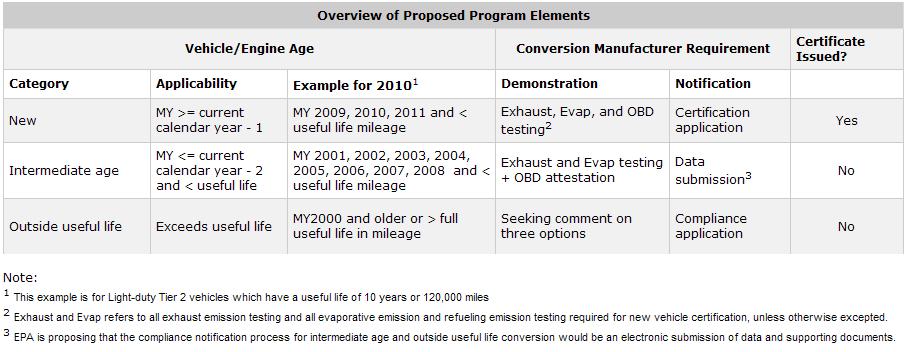|
| |
|
EPA -
Alternative Fuels |
| |
|
| What I get
from the following information, provided by the EPA, is that any vehicle
that converts to using a different fuel than what it was manufactured to
use, will have to file for a conversion permit, good for one year; and
re-file each year there after. Your conversions must meet or exceed the
original efficiencies of the original manufacturing emissions. Without
EPA approval, you are in violation of EPA laws. Using HHO as an
additive is not the same thing as converting to a different fuel. Using
100% HHO is. If you are identifying your HHO vehicle as a Hybrid, you
may have some explaining to do. Actually, according to EPA's definition
of an Additive, HHO is not considered an additive. It is not added to
the fuel itself. It is added to the air. It does contain Hydrogen, which
is considered a fuel, but the hydrogen does not replace the gasoline,
nor is it added to the gasoline. Water injection would fall under the
same category as HHO. What category would that be? |
| |
|
| |
|
| EPA
Proposes New Compliance Options for Clean Alternative Fuel Vehicle and
Engine Conversions: Regulatory Announcement EPA420-F-10-002, May 2010
Download PDF version
formatted for print (5
pp, 1.05MB, About
PDF Files )
The U.S. Environmental Protection Agency (EPA) is
proposing to amend the current regulations for aftermarket fuel
conversions, which took effect on September 21, 1994 (40 CFR part 85
subpart F). This proposal updates regulations that apply to
manufacturers of light-duty vehicle and heavy-duty highway vehicle and
engine clean alternative fuel conversion systems. The proposed revisions
would streamline the compliance process while maintaining
environmentally protective controls.
Overview
While the vast majority of vehicles in the United States
are designed to operate on gasoline or diesel fuel, there has been a
growing interest from the public in aftermarket fuel conversion systems.
These systems allow gasoline or diesel vehicles to operate on
alternative fuels such as natural gas, propane, alcohol, or electricity.
Use of clean alternative fuels opens new fuel supply choices and can
help consumers address concerns about fuel costs, energy security, and
emissions.
EPA supports such innovation and encourages the
development of clean aftermarket technologies that enable broader
transportation fuel choices. At the same time
EPA is responsible for ensuring that all vehicles and engines sold in
the United States, including aftermarket conversions, meet emission
standards.
EPA is proposing a new approach that would simplify and streamline the
process by which manufacturers of clean alternative fuel conversion
systems may demonstrate compliance with vehicle and engine emissions
requirements. The new options would reduce some economic and procedural
impediments to clean alternative fuel conversions while maintaining
environmental safeguards to ensure that acceptable emission levels from
converted vehicles are sustained. The proposed rule would cover
conversions of light-duty vehicles and heavy-duty highway vehicles and
engines, and would apply to all clean alternative fuels.
Current EPA regulations require vehicle and engine conversion systems to
be covered by a certificate of conformity to gain a regulatory exemption
from potential tampering charges.
EPA evaluated this requirement and believes it is appropriate to
introduce new flexibilities for all clean alternative fuel converters
and expand the compliance options in certain conversion situations. EPA
proposes to amend the regulatory procedures in 40 CFR part 85 subpart F
and part 86 to establish these new compliance options.
The proposed approach builds on the concept that it is
appropriate to treat conversion requirements differently based on the
age of the vehicle or engine being converted. Testing and compliance
procedures would differ based on the age category of the vehicle or
engine that is converted: new and nearly new, intermediate age, or
outside useful life. All conversion manufacturers would need to
demonstrate compliance with EPA requirements, but the requirements would
differ among age categories. EPA expects the streamlined approach to
result in a cost savings for many converters.
Key Elements of the Proposed Rulemaking
The Clean Air Act prohibits changing a vehicle or engine from its
certified configuration.
Alternative fuel conversion systems alter one or more elements of a
vehicle or engine's original configuration to enable operation on a new
fuel. This action provides a compliance option that allows conversion
manufacturers to make the necessary changes without violating the law.
It also establishes a clear and comprehensive compliance pathway for
alternative fuel converters to gain exemption from the prohibition
against tampering.
The proposed compliance program would enable conversion
manufacturers to qualify for an exemption when they demonstrate that the
converted vehicle or engine satisfies EPA emissions requirements. The
specific notification (application) and demonstration requirements would
differ based on the age of the vehicle or engine being converted. The
notification and demonstration requirements for new and nearly new
vehicles and engines would remain very similar to current certification
requirements. The requirements for intermediate age vehicles and engines
would involve testing and submission of data to show that the converted
vehicle or engine continues to meet applicable standards. EPA is seeking
comment on three possible demonstration options for vehicles and engines
that have exceeded their regulatory useful life. These age-based
categories and requirements are summarized below:

|
 More Details
More Details |
|
 Fuel Additive Manufacturer Instructions
(defines additives)
Fuel Additive Manufacturer Instructions
(defines additives) |
|
| |
|
|
Page Last Edited -
04/03/2022 |
|
|